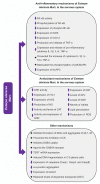What We Know about Euterpe Genus and Neuroprotection: A Scoping Review
- PMID: 37513607
- PMCID: PMC10384735
- DOI: 10.3390/nu15143189
What We Know about Euterpe Genus and Neuroprotection: A Scoping Review
Abstract
The Euterpe genus (mainly Euterpe oleracea Martius, Euterpe precatoria Martius, and Euterpe edulis Martius) has recently gained commercial and scientific notoriety due to the high nutritional value of its fruits, which are rich in polyphenols (phenolic acids and anthocyanins) and have potent antioxidant activity. These characteristics have contributed to the increased number of neuropharmacological evaluations of the three species over the last 10 years, especially açaí of the species Euterpe oleracea Martius. The fruits of the three species exert neuroprotective effects through the modulation of inflammatory and oxidative pathways and other mechanisms, including the inhibition of the mTOR pathway and protection of the blood-brain barrier, all of them intimately involved in several neuropathologies. Thus, a better understanding of the neuropharmacological properties of these three species may open new paths for the development of therapeutic tools aimed at preventing and treating a variety of neurological conditions.
Keywords: Amazon; CNS; Euterpe; Euterpe edulis; Euterpe oleracea; Euterpe precatoria; açaí; brain; juçara; neuroprotection.
Conflict of interest statement
The authors declare no conflict of interest.
Figures








References
Publication types
MeSH terms
Substances
Grants and funding
LinkOut - more resources
Full Text Sources
Miscellaneous

